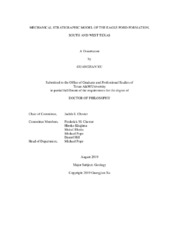| dc.description.abstract | Mechanical stratigraphy strongly impacts the growth of hydraulic fractures in shale reservoirs. Without a complete understanding of the properties of the target and surrounding intervals, it is hard to predict the bulk mechanical response of these zones, including the surrounding layers. Due to limited access to the core from productive fields, a complete mechanical characterization often is lacking. Outcrop and core from a condensate producing reservoir provide a great opportunity to characterize the geomechanical properties of individual and composite lithologic units of the Cretaceous carbonaceous Eagle Ford Formation over length scales of a decimeter to tens of meters. This study employs extensive triaxial deformation experiments on samples of the Eagle Ford Formation, as well as detailed lithostratigraphic characterizations of the sampled outcrop and subsurface well site, to define the elastic and inelastic properties and relate them to lithologic characteristics. The Eagle Ford Formation exhibits a wide variation in elastic modulus as a function of carbonate facies. The reservoir rock samples also show a moderate pressure dependency when compared to the outcrop samples, especially under low-pressure conditions. The latter difference is likely related to crack-like pores and microcracks in the reservoir rocks that result from decompression. Under reservoir conditions, Young’s modulus and Poisson’s ratio increase by a factor of 4 and 1.5, respectively. Young’s modulus and Poison’s ratio increase similarly with an increase in carbonate content, and a decrease in organic matter and clay mineral fraction. Young’s modulus also increases with an increase in the ratio of grains to mud-size particles, quantified by the grain fraction. This latter relation is most significant for the mudstone and wackestone facies with relatively large mud matrix. Both Young’s modulus and Poisson’s ratio of the Eagle Ford Formation can display anisotropy with a directional variation of ~40%, most notably in micro-laminated and clay-rich rocks. The degree of anisotropy is positively correlated with clay mineral content, with the greatest change occurring in mud-supported facies. The inelastic strength properties of yield strength, ultimate strength, and coefficient of sliding friction are determined as a function of confining pressure to quantify failure criteria and a fracture mode criterion appropriate to hydrofracture. The ultimate strength increases by a factor of 2 from the mudstone to packstone/grainstone facies. Ultimate strength increases gradually with confining pressure. All carbonate facies deformed by formation of brittle failure macroscopic faulting displaying the greatest localization under low-stress conditions. The angle of the failure plane is not sensitive to facies type, yet it does increase with confining pressure. Clay minerals have a significant impact on ultimate strength and decrease by 50% for clay contents ranging from 0 to ~10%. Yet increasing clay mineral content does not promote an increase in ductility over the conditions tested. The ultimate strength increases with increasing grain fraction for samples with 0-50% grain fraction with more subtle changes above 50%. Based on the laboratory mechanical data, six brittleness indices are derived and compared with the mechanical properties. Most of the brittleness indices increase from the mud-supported to grain-supported facies. Young’s modulus and ultimate strength show a positive trend with the composition-based brittleness and pre-fracture strain-based brittleness indices, suggesting that Young’s modulus could be used to estimate brittleness of the formation if the rock fails in a predominantly brittle manner. A mechanical stratigraphic model of the Eagle Ford Formation is constructed based on detailed lithostratigraphic descriptions of the Eagle Ford Formation using visual observations and a relatively simple lithologic classification scheme, and then applying average mechanical properties for each lithology, combined with simple averaging schemes, to determine the effective behavior of the multilayered formation. The mechanical properties of the Eagle Ford Formation vary systematically with mineralogy, composition, and textural characteristics (i.e., recrystallized grains, grain fraction), and effective confining pressure, which can be expressed with quantitative relationships. The experimental data also supports robust quantitative relationships between elastic and inelastic mechanical properties. Accordingly, a mechanical stratigraphic model describing inelastic behaviors including brittleness can be constructed indirectly from geophysical and rock physics interpretation of logging data. | en |


